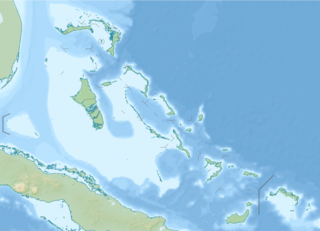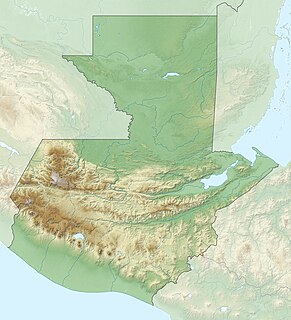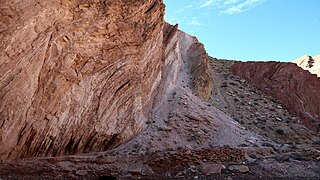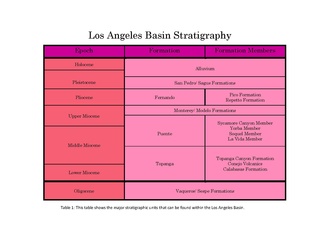 W
WThe Ambergris Caye Limestone is a geologic formation in Belize. It preserves fossils dating back to the Late Pleistocene period.
 W
WThe Anguilla Formation is a geologic formation in Anguilla. It preserves fossils dating back to the Burdigalian to Serravallian period.
 W
WThe Ash Hollow Formation of the Ogallala Group is a geological formation found in Nebraska and South Dakota. It preserves fossils dating back to the Neogene period. It was named after Ash Hollow, Nebraska and can be seen in Ash Hollow State Historical Park.
 W
WThe Belmont Formation is a geologic formation in Grenada. It preserves fossils dating back to the Burdigalian period.
 W
WThe Caloosahatchee Formation is a geologic formation in Florida. It preserves fossils dating back to the Neogene period.
 W
WThe Canímar Formation is a geologic formation in Cuba. It preserves fossils dating back to the Late Miocene to Pliocene period. Among others, fossils of megalodon have been found in the formation.
 W
WThe Carriacou Formation is a geologic formation in Grenada. It preserves fossils dating back to the Early Miocene period.
 W
WThe Chesapeake Group is a geologic group in Maryland, Virginia, Delaware, and North Carolina. It preserves mainly marine fossils dating back to the Miocene and Pliocene epochs of the Neogene period. This group contains one of the best studied fossil record of Neogene oceans in the world. Professional Paleontologists and amateur fossil hunters alike collect from this group intensely. The Calvert Cliffs stretch the length of Calvert County, Maryland and provide the best continuous stretch of the Calvert, Choptank, and St. Marys Formations. Ward (1985) recommended including the Old Church Formation in this group.
 W
WThe Cipero Marl is a geologic formation in Trinidad and Tobago. It preserves fossils dating back to the Early Oligocene to Burdigalian period.
 W
WThe Coralline Crag Formation is a geological formation in England. The Coralline Crag Formation is a series of marine deposits found near the North Sea coast of Suffolk and characterised by bryozoan and mollusc debris. The deposit, whose onshore occurrence is mainly restricted to the area around Aldeburgh and Orford, is a series of bioclastic calcarenites and silty sands with shell debris, deposited during a short-lived warm period at the start of the Pliocene Epoch of the Neogene Period. Small areas of the rock formation are found in locations such as Boyton and Tattingstone to the south of Orford as well as offshore at Sizewell.
 W
WThe Empire Formation is a geologic formation in Oregon. It preserves fossils dating back to the Neogene period.
 W
WThe Etchegoin Formation is a Pliocene epoch geologic formation in the lower half of the San Joaquin Valley in central California.
 W
WThe Fort Thompson Formation is a geologic formation in Florida. It preserves fossils dating back to the Neogene period. It was influenced by sea level changes.
 W
WThe Grand Bay Formation is a geologic formation in Grenada. It preserves fossils dating back to the Middle Miocene period.
 W
WThe Grotto Beach Formation is a geologic formation in the Bahamas. It preserves fossils dating back to the Middle to Late Pleistocene period.
 W
WThe Güines Formation is a geologic formation in Cuba. It preserves fossils dating back to the Early to Middle Miocene period. Among others, fossils of the prehistoric dugong, Metaxytherium were found in the formation.
 W
WThe Herreria Formation is a geologic formation in northeastern Guatemala. It preserves fossils dating back to the Miocene period.
 W
WThe Highlands Formation is a geologic formation in Antigua and Barbuda. It preserves fossils of Megalodon dating back to the Pliocene period. Among others, the formation has provided fossils of megalodon.
 W
WThe Horse Spring Formation is a geologic formation in Nevada. It preserves fossils dating back to the Neogene period. The lower unit is conglomerate and the middle and upper are sandstone and freshwater limestone.
 W
WThe Imías Formation is a geologic formation in Cuba. It preserves fossils dating back to the Miocene period.
 W
WThe Las Cahobas Formation is a geologic formation in Haiti. It preserves fossils dating back to the Middle to Late Miocene period.
 W
WThe Lucayan Formation is a geologic formation in the Bahamas. It preserves fossils dating back to the Early Pleistocene period.
 W
WThe Marsland Formation is a geologic formation in Nebraska. It preserves fossils dating back to the Neogene period.
 W
WThe Matanzas Formation is a geologic formation in Cuba. It preserves fossils dating back to the Late Pliocene period.
 W
WThe Matura Formation is a geologic formation in Trinidad and Tobago. It preserves bivalve and gastropod fossils dating back to the Pliocene period.
 W
WThe Moraga Formation or Moraga Volcanics is a Pliocene epoch volcanic geologic formation in the Berkeley Hills of the East Bay region of the San Francisco Bay Area, California.
 W
WThe Morne l'Enfer Formation is a geologic formation in Trinidad and Tobago. It preserves fossils dating back to the Miocene to Early Pliocene period.
 W
WThe Narrow Cape Formation is a geologic formation in the Kodiak Archipelago, in Alaska. The formation outcrops along Narrow Cape and nearby Ugak Island. It preserves fossils dating back to the Neogene period. Invertebrate fossils are abundant, along with rare vertebrate fossils.
 W
WThe Ogallala Formation is a Miocene to early Pliocene geologic formation in the central High Plains of the western United States and the location of the Ogallala Aquifer. In Nebraska and South Dakota it is also classified as the Ogallala Group. Notably, it records the North American Land Mammal Ages (NALMAs) Hemphillian, Clarendonian, and Barstovian. It also includes an excellent record of grass seeds and other plant seeds, which can be used for biostratigraphic dating within the formation. The Ogallala Formation outcrops of Lake Meredith National Recreation Area preserve fish fossils. Similar specimens from the same unit are found at Alibates Flint Quarries National Monument in Texas.
 W
WThe Puente Formation is a geologic formation in California. It preserves fossils dating back to the Neogene period.
 W
WThe Punchbowl Formation is a sedimentary sandstone geologic formation in the northern San Gabriel Mountains, above the Antelope Valley in Los Angeles County, southern California.
 W
WThe Purisima Formation is a geologic formation in California. It preserves fossils dating from the Late Miocene to Early Pleistocene.
 W
WThe Rivière Gauche Formation is a geologic formation in Haiti. It preserves fossils dating back to the Pliocene period.
 W
WThe Talparo Formation is a geologic formation in Trinidad and Tobago. It preserves fossils dating back to the Early Pliocene period.
 W
WThe Tamana Formation is a geologic formation in Trinidad and Tobago. It preserves fossils dating back to the Burdigalian to Serravallian period.
 W
WThe Thomonde Formation is a geologic formation in Haiti. It preserves fossils dating back to the Early to Middle Miocene period.
 W
WThe Ville Formation is a geologic formation in Germany. It preserves fossils dating back to the Neogene period. Lignite of the Ville Formation is excavated in North Rhine-Westphalia.
 W
WThe Yakataga Formation is a geologic formation in Alaska. It preserves fossils dating back to the Neogene period.